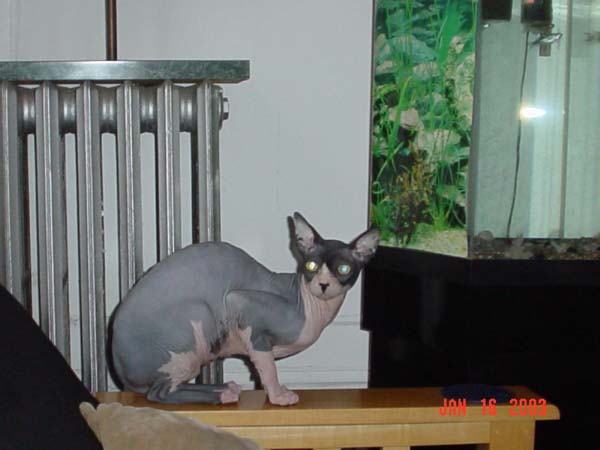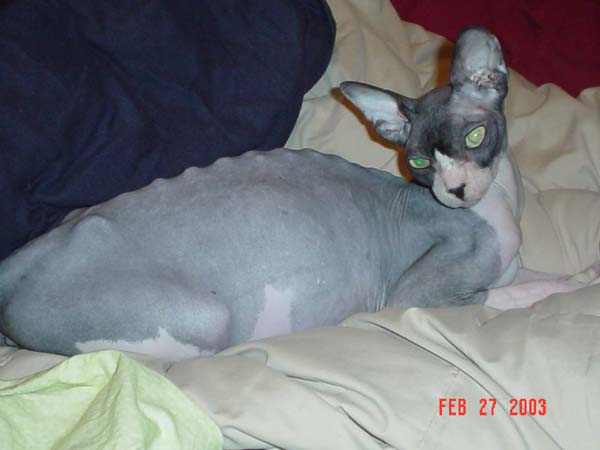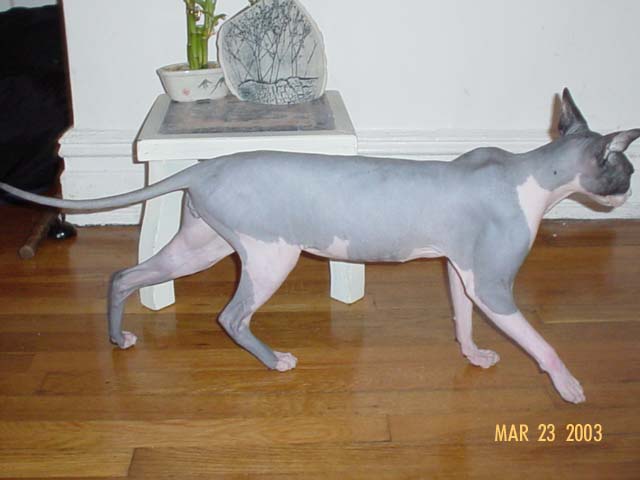[Please note I do not endorse any advertisements you may see on my website. These are placed without my control by angelfire in return for a "free" website.]
Mantis is the Sphynx cat who had FIP and whose copyright photos I use with permission and thanks,
as I present his case here and my principles of approach using homeopathy.
Here is Mantis, a skinny kitty in Jan 2003 and with his activity slowed down from normal and he is not yet showing the bloated abdomen of "wet" FIP in this photo. He started to decline in health in late October of 2002 and reached his worst point in Feb 2003. Most FIP kitties have the disease for a while before diagnosis of FIP is made:

Mantis is a neutered male Sphynx cat. He appears hairless, but has a peach fuzz type coat.
He lives in New York. Almost a month after the above photo was taken, Mantis started to swell up with abdominal fluid.
The vet saw him about 13 Feb 2003, but he made no improvement and by the end of February vet visit he was in very bad shape.
His owner, Jesse, contacted me after reading my website article on FIP here:
FIP 2001 knowledge.
I received an email with the subject heading, "Help I think my cat has FIP!". Jesse also sent blood work,
and two photos to show how Mantis looked mid-January as above, and how he looked on the day Jesse first
contacted me after coming home from the vet visit on 27 Feb 2003:
This is Mantis in February 2003, a very ill cat indeed:

You can see that Mantis is really a starving cat, with bones showing prominently. The bloated fluid-filled abdomen is deceptive. He has lost muscle mass and the strength to jump well and has no energy. He lies on the bed, not able to be a normal active cat.
His owner was able to acquire the food, nutrient supplements and a remedy he asked me to repertorize and which he purchased within a day of contacting me. He also declined the use of prednisone (a steroid), and I believe these factors and his excellent nursing (round the clock when necessary at first) made the difference in a touch and go situation.
I'll add some case details here at a later stage. For today I wish to at least put the photos up on my website in hopes that more people will see that even in a seriously ill cat, it can be worthwhile to follow a homeopathic and nutritional approach and success is possible. Homeopthy does not treat a disease, it aims to build health, and if this is greatly successful, then any disease that is present may not have a good enough foothold to stick around in a healthy individual.
Every case is different and there is never a guarantee of success in builing health. However I feel that I have developed an approach that gives better general health to severely ill cats with FIP type symptoms (with or without diagnosis that being the preserve of a licensed vet) than other approaches to support and nurse cats with FIP type symptoms and I would like to share this approach with other homeopaths in the hope that it may help more cats with FIP type symptoms to get the home support they need.
An outline of the principles I used is below on this page. Every cat is differnt and in homeopathy there is no standard approach but rather a very individualized one to whatever situation the cat currently is in.
After homeopathic support for just over three weeks, Mantis has recovered his muscle mass,
his backbone is padded with muscle again and his legs are strongly muscled, he
has lost the volume of fluid in his abdomen, and is rushing about and playing as a happy cat again in March 2003:

At time of writing, (25 Mar 2003) Mantis is still on a regime to build resistance and to balance
his immune system for greater health, and this will be tapered off in time.
Sept 2003 update: Mantis doing well.
May 2006 update: Mantis had a viral infection April 06, but is now well again.
Here is a brief description of the principles I had in mind
when planning my approach to a cat with a swollen belly as is often seen in FIP cases.
This case is unique in that the cat was in an advanced stage of disease when I first heard fromt he owner, as opposed to an early case which is easier to get to respond and develop health, using homeopathy. As far as I know conventional medicine has no answer to FIP symptoms other than trying to delay the end with cortisone. Homeopathy ignores the disease and buoilds basic health. The vcat's body is then expected to do what it will and sometimes the FIP disease then finds itself in a healthy body and can't sustain itself there.
I suspect this may be breaking new ground as an appoach in any case as the homeopathy texts I have referred to suggest ways that may alleviate some symptoms of FIp through increased health, but do not build back the general health sufficiently to result in a healthy enough cat so it does not support FIP. I repertorized without considering any of the "palliation" remedies in the textbooks and personally do not see
them as appropriate based on what I know of the actual homeopathic symptoms/characteristics of the FIP-type condition.
My approach is one I devised
based on scientific knowledge of how FIP works, my knowledge of the
immune system plus recent research on how the immune system can be
skewed, and combining that with homeopathy knowledge. I have a year 2001
article on FIP on my website for background on the illness itslef. (The link is given higher up on this page.)
The most relevant issues to me are that FIP is an immune system imbalance situation in which the cellular immune system
is inactive (in "wet" FIP) and the humoral antibody immune system is overactive. It's the antibodies not the virus, that
kill the cat in FIP.
The virus finds a blood cell wall to attach to. It's when the antibodies over-respond that the blood vessel leaks, allowing the nutritient-rich blood plasma to leak into the body cavity where all those nutrients are no longer accessible to the cat. So it's basically a starvation by loss of blood plasma that characterizes this disease. The blood cells do not leak out, but the fluid that builds up is a yellow sticky one, rich in globulins and nutrients "stolen" from the blood stream. I used this fact of "loss of body fluid" as a symptom - more correcetly a homeopathic"rubric" in my repertorising to fully represent the status quo iof the ct in question, as well as other appropriate symptoms specific to Mantis. A different cat might need a different remedy. Perhaps it would prefer differnt weather or have a different stool characteristic. Whatever is the picture of the cat at the time, is what determines the repertorizing rubrics (homeopthic characteristics are called rubrics).
I believe that I used a new way of thinking for diseases that progress faster than I feel one can normally respond to symptoms. In this kind of disease, the status quo of the individual cat can change so fast you practically have to repertoriize a few times a day to be on trck. But insted of doing that I tried to guess at the future picture I would see based on kowldege of the disease - to try to pre-empt the changes in characteristics. Homeopathy in principle gives a remedy matched to symptoms. What I did with this cat was to give a remedy matched to the symptoms still to develop and likely to develop next, combined with those seen and those typical of the individual personality. So I feel that was a major departure from the usual homeopathy approach in selecting a matching remedy.
The client also used far more doses per day than usual but started with very low potency as the cat was very ill - and changed potency upward a lot faster than is usually done. My overall principle as I explained - was to get maximum use of low potency to build the cat's strength but to dose often and change potency upward faster than the disease could progress. I felt this was like a race, to make sufficient progress in general health improvement with each potency of remedy, so that it could strengthen the cat for the next potency. Yet I knew the disease was swift and that there was not a lot of time left to me in which I would need to reach a high potency towards health - to match a high disease strength. A serious disease always needs a higher potency to achieve health, but a seriously ill cat can not handle a high potency, it has to be built up first. Hence I devised this technique to try to work up in potency in an ill cat and still "outrun" the disease progress rate. My client chose to try the suggested technique for building health, there being no other options in terms of any known successful treatments for the disease - there are none - so it was worth trying to build the health back with homeoapthy.
The principle I wanted to use was to get ahead of the disease and "lie in wait" with the right remedy at the right potency already in place in the cat before the very next severe symptom was due to arrive. The idea was to put a body in place, too healthy for that degree of diease. This is a dicey principle as a remedy of too high dose or potency would overwhelm a very ill individual so that it would be wasted rather than building health, so the principle was to climb the scale at the maximum rate the cat could tolerate and keep working to achieve this and work up the potency scale as fast as possible safely. At one point it seemed I could slack off the fast pace, but that was a mistake, and it is better to err on the side of too frequent dosing with and situation progressing as fast in terms of health breakdown as FIP does than to "play safe". There is definitely no opportunity to wait and see what each homeopathic dose does with this situation in my opinioin. I explained my ideas and principles to the client who had the task of choosing to try this or not. And obviously he did, by purchasing several potencies of a repertorized remedy and using them in succession according to the explained principles. It is necessary to pre-empt the disease in my view.
A lot of credit is due to the owner and also due to the fact that the remedies were obtainable quickly. The owner is in New York where there is a major remedy supplier, so the first potency of the matched remedy was available in 24 hours or less, and the other potencies were on hand in advance of need. The owner also followed all my instructions on principles though he had to make the judgements and did the heavy nursing, including round the clock at first, but kept up with the intense pace and was fast to get all the appropriate nutrients and potency changes for the remedy that matched in the repertorizing. We knew it was touch and go.
This case was handled without my ever seeing the cat, by email. I find this an excellent approach to homeopathic assistance as this is not a well known field to the client, and email gives the opportunity to answer questions in a way the client can mull over them, and also gives a dead-tired client written information which can be referenced as often as necessary so as to have no misunderstanding. It takes a lot of time to manage a situation this way, for example this one has 72 emails to date. However the logging of case details is automatic - and the homeopath has the huge advantage that the description of the cat's symptoms is available in writing, in the client's own words. The client has the option of showing the information to whomever he pleases incouding his vet before choosing whetgher to use the health building system or not, according to the approach outlined in principle.
In my opinion there is no better way to do a homeopathy consult for animals. It is a simple matter to attach photos, lab results, a log of nursing and dosing, and even xrays, so that all pertinent symp[toms of the individaul can be considered in the repertorizing. These can be done at the convenience time-wise of both client and homeopath, which results in a much higher quality result. The veterinary clinic is of course essential for the relevant aspects of diagnosis prognosis, testing and any other aspects that might be appropriate, such as treatment of disease if available (which it was not for FIP) but the homeopathy support aspect works wonderfully, with great documentation, by email.
The case is not completed. The cat is doing fine, playing and eating and enjoying being up to mischief, but there is still a tapering period with the remedy to build resistance to recurrence, and the cat has been started on an immune building supplement and food regime for that as well. But I think we are "out of the woods" enough to start to report on this approach to ill cats with severe terminal disease such as this cat with FIP symptoms. I stress that the approach taken was homeopathy to build health and was not any practise of veterinary medicien such as diagnosis, pronosis or treatment of disease. The homeopathy approach recognizes that the cat has a disease, but neither diagnoses nor treats it. It only aims to build health based on the status and characteristics of the individaul without any diagnosis.
I especially hope you enjoy the photos of progress as much as I do.
......copyright Irene de Villiers 2003
FURRY BOOTS NORWEGIAN FOREST CATS - HOME PAGE
Furry Boots Home & Website Index